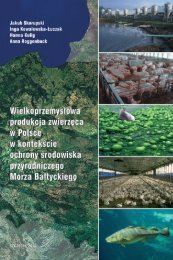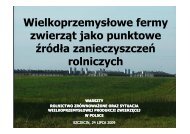best available technologies for manure treatment - Baltic Green Belt
best available technologies for manure treatment - Baltic Green Belt
best available technologies for manure treatment - Baltic Green Belt
You also want an ePaper? Increase the reach of your titles
YUMPU automatically turns print PDFs into web optimized ePapers that Google loves.
Best Available Technologies <strong>for</strong> <strong>manure</strong> <strong>treatment</strong> baltic sea 2020<br />
4: RESULT OF DATA ANALYSIS<br />
4: RESULT OF DATA ANALYSIS<br />
4.1: Reduced list of livestock <strong>manure</strong><br />
handling <strong>technologies</strong><br />
The complete list of identified livestock <strong>manure</strong><br />
<strong>treatment</strong> <strong>technologies</strong> has been reduced in different<br />
ways in relation to the specific needs and purposes of<br />
this project. Technologies that are without leaching<br />
reduction effect, that are not commercially implemented,<br />
that are not in focus in this project, that<br />
have apparent other negative impacts on the environment,<br />
that have no proven or unacceptable economic<br />
per<strong>for</strong>mance, or have ethical considerations have<br />
been removed.<br />
4.1.1: Non–project relevant <strong>technologies</strong><br />
It is <strong>for</strong> this project given on be<strong>for</strong>ehand, that focus is<br />
not on <strong>technologies</strong> in relation to evaporation (emissions),<br />
storage or spreading of livestock <strong>manure</strong>s.<br />
4.1.2: Technologies that are not<br />
commercially implemented<br />
A number of the <strong>technologies</strong> we have identified are<br />
still being researched or piloted, and we can of this<br />
reason not recommend them to be put into operation<br />
on a broad scale in the BSR.<br />
4.1.3: Technologies without leaching<br />
reduction effect<br />
Some of the <strong>technologies</strong> have neither directly or<br />
indirectly any leaching reduction effect.<br />
4.1.4: Technologies with apparent negative<br />
environment or climate impacts<br />
Especially the aeration <strong>technologies</strong> are reported to<br />
lead to smaller or larger evaporation of laughter gases<br />
and ammonia. Seepage is also seen in connection to<br />
composting, when material <strong>for</strong> composting with less<br />
than 30% dry matter is placed on the bare soil.<br />
There<strong>for</strong>e, of the aeration <strong>technologies</strong> we do<br />
alone recommend that the fibre fraction from separation<br />
is composted in order to make it<br />
• stable in the storage, i.e. it will not start fermenting,<br />
moulding, leaching, evaporating or other<br />
during storage and transport; and<br />
• with a high dry matter percentage, as we acknowledge<br />
that composting is an effective and cheap<br />
way to remove water from a substrate without<br />
consumption of external energy, because the<br />
temperatures normally raises to above 70°C<br />
during the composting process – a high dry<br />
matter percent is especially important if the fibre<br />
fraction shall be used in a later thermal gasification<br />
or combustion process.<br />
If composting of the fibre fraction is done, then we<br />
recommend it happens in a way so that neither emissions<br />
of harmful gases nor seepage is possible, i.e. it<br />
should be in closed containers.<br />
4.1.5: No proven or unacceptable economic<br />
per<strong>for</strong>mance <strong>for</strong> general use<br />
Despite having been implemented in practice, meaning<br />
that we could not consider the <strong>technologies</strong> as<br />
being research or piloted, we are in doubt about their<br />
viability in commercial use without subsidisation.<br />
These <strong>technologies</strong> counts <strong>for</strong> instance those that are<br />
related with total purification of the liquid fraction,<br />
as well as the temperature and pressure <strong>treatment</strong>,<br />
which seems mainly to be relevant in case of a need<br />
to treat animal by-products.<br />
4.1.6: Technologies with ethical<br />
considerations<br />
We do not see any ethical considerations <strong>for</strong> any of<br />
the listed <strong>technologies</strong> in Table 6.<br />
However, we remind that N is an expensive and<br />
limiting resource in the agricultural production,<br />
where<strong>for</strong>e it seems uneconomic to convert it to free<br />
N (N2), rather than using it <strong>for</strong> fertilising of crops<br />
instead of buying N fertilisers, that have been produced<br />
with high consumption of fossil fuels.<br />
We also remind that P is a scarce resource, and<br />
that there is a risk that the P in the ash after combustion<br />
of livestock <strong>manure</strong> is converted to <strong>for</strong>ms with<br />
low plant availability.<br />
30








